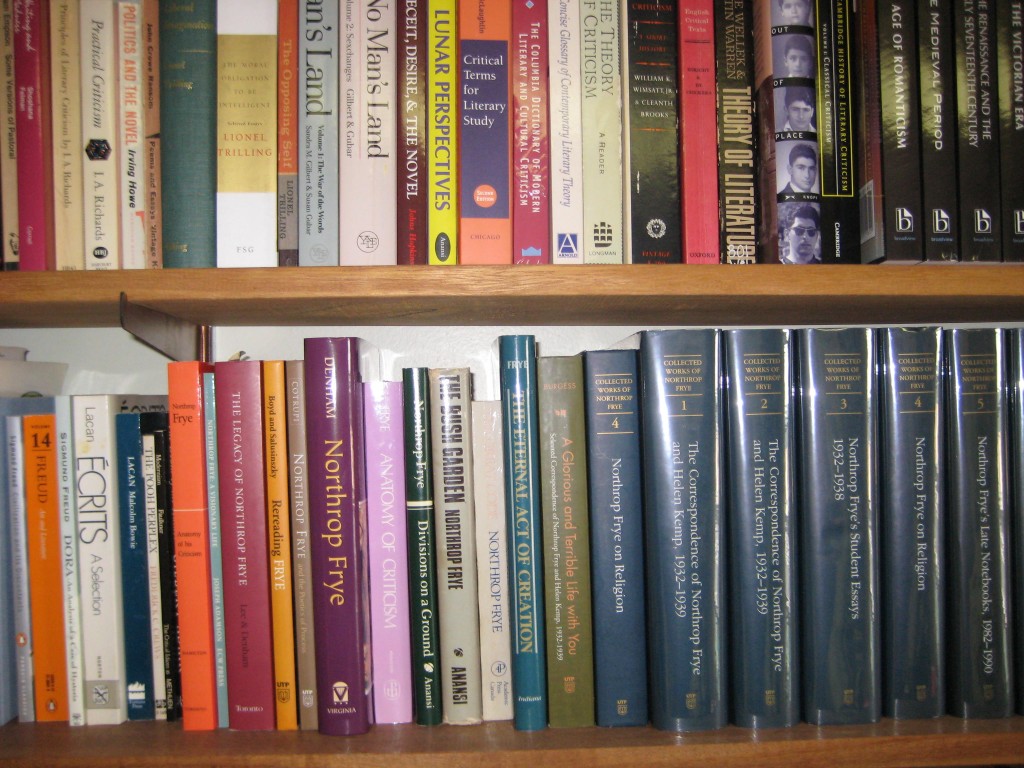With this post, I am inaugurating a series documenting a year of teaching English, in which I plan to highlight the part played by Northrop Frye’s ideas. For me, Frye has always been more important for my teaching than for my scholarly research and critical writing. I am beginning now, rather than in September, because I have already had to do some thinking about my courses for the next academic year, which were assigned late in 2009. Entries for the department Handbook were due last week, and that means I had to decide on at least the main focus and the assigned textbooks for the courses that I will be teaching. If I find I have enough to say, and the energy and commitment to keep it up, I will post in this series until the end of classes in April, 2011. (Academic life certainly keeps you planning ahead!)
First, a few words of introduction. Teachers often keep journals for personal use, and there have been numerous publications such as James Phelan’s Beyond the Tenure Track: Fifteen Months in the Life of an English Professor (1991), a detailed account of events both professional and personal in the life of a professor moving into the mid-career phase. More recently, many students, professors, deans and other administrators write blogs in which academic life is a major focus. I was partly inspired to start this series by the example of Rohan Maitzen’s regular feature “This Week in My Classes” at her blog Novel Readings. I do not plan to write a detailed diary about my teaching, and I will not provide regular commentary on what goes on in the classroom. The plan is to write about some of the decisions I make, especially about what texts I choose and how I teach them. In so doing, I will consider in what ways and to what extent Frye is a vade mecum for my work as a university teacher of English. I hope that these occasional journal entries will be of some interest and use to other teachers and to students in the discipline.
To set the scene, I teach at Saint Mary’s University, a former Jesuit college that is now a medium-sized public university. (I once taught Joyce’s Portrait of the Artist in a panelled classroom that had formerly been the Jesuits’ dining room). We have an English department of 19 full-time members and offer a wide range of courses for a department of our size. In 2010-2011, I am scheduled to teach a section of the first-year Introduction to Literature, the second-year survey course English Literary Traditions (6 hours), a third-year course on British literature from 1900-45, and an advanced course on the novels of the Brontë sisters.
In the survey course, along with the usual Norton anthology, I have decided to teach Measure for Measure, Sense and Sensibility, Frankenstein, and Hard Times. These are all comfortable choices for me, and usually popular with the students. The British course is a new one. Thinking about my plans, I realize that they involve historical context and cultural studies to a fairly large extent, and also the dialectic between modernism and realism. In spite of my love of at least some of the masterpieces of modernism, I have a fondness for the alternative poetic tradition that was championed by Philip Larkin, and for the English tradition of fictional realism that continued through the modernist period. I will be teaching novels by E. M. Forster, Virginia Woolf, and Graham Greene. Frye’s discussion in the Anatomy of realism and symbolism as two opposing literary poles will be useful in mapping the literature of the first half of the twentieth century, along with David Lodge’s The Modes of Modern Writing. The influence of Yeats and Eliot, and then of Auden, can also usefully be described in the terms set out by Harold Bloom in his books on poetic influence. As for the Brontës, another new course – thank goodness I am on leave at the moment! – my entry for the Handbook does little more than list the books, noting that there were three sisters, not two, and that Charlotte wrote more than just Jane Eyre. The psychological and the sociological will figure prominently in this course, I expect, as will a kind of comparative phenomenology of the sisters’ novels. Of course, I will go back to Frye on romance, and I recall a number of entries on Charlotte Brontë’s Shirley in the notebooks.
That’s it for my first entry, and I imagine that I will add to this journal infrequently until late in the summer, when preparations for the academic year begin in earnest.
